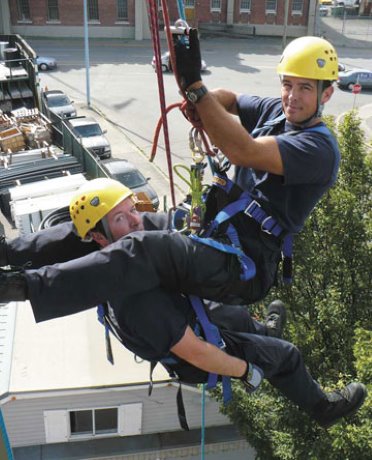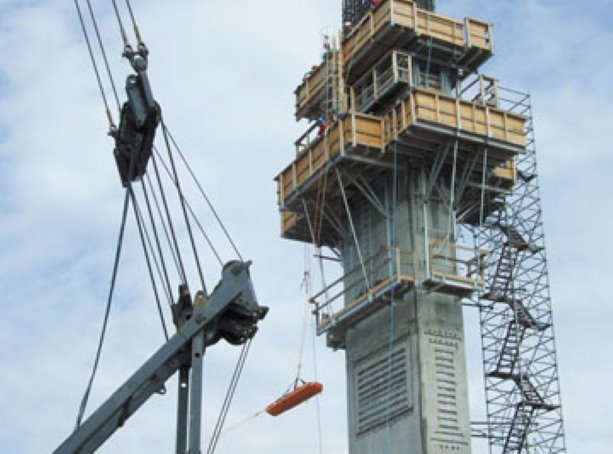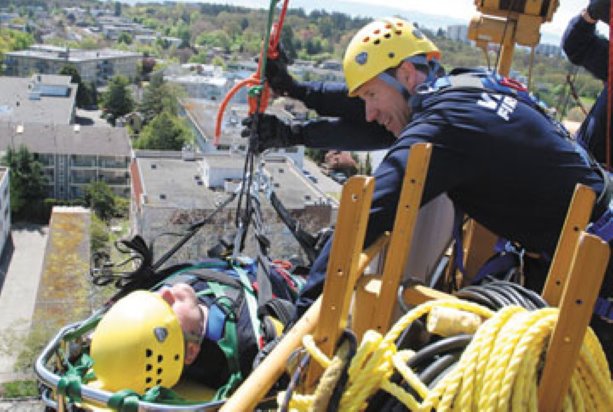High angle rope training is being provided to fire fighters in B.C. through a program that has been expanded to ensure fire departments across the province can rescue construction workers at high elevations.
“It’s a unique program and there is no other program funded like this in the world,” said Cathy Lange, a consultant that manages the Technical High Angle Rope Rescue Programme (THARRP) for the B.C. Construction Safety Alliance.
“We pay for the training of instructors and they must make a commitment of three years once they get the training.”
Contractors in B.C. are required by law to provide the necessary high elevation rescue services for construction workers, as part of their safety protection plan.
However, maintaining a highly-trained and fully-equipped rescue team on standby at construction sites is prohibitively expensive.
In response to this problem, B.C. has devised an original approach to provide training for high-elevation rescues.
THARRP, through WorkSafeBC, provides funding for representatives of selected fire department to achieve training every three years.
These representatives obtain qualifications to train members of their own fire departments in the rescue of victims from high elevations or terrain with a slope angle of 60 degrees or more.
“Its expensive for fire departments to maintain this program,” said John Kenyon, a director at Dynamic Rescue Systems. “Without this funding, they couldn’t do it. The level of safety and service is increased with the funding.”
The program was launched by WorkSafeBC in 1995 and was initially managed by the Justice Institute.
Another training provider called Roco was added in 2007.
According to Lange, the biggest change for this program in the last year is that the THARR Program or Steering Committee has recognized several new training providers including Dynamic Rescue, Canpro and Raven Rescue.
“It is up to fire departments to get training to national fire protection standards.”
High elevation rescue is similar to other work already done by firefighters, but it is not generally covered in their basic training.
THARRP fills the gap by providing firefighters with 160 hours of rigorous and specialized training.
One fourth of this training deals specifically with tower crane rescues.
Lange said individual fire departments get approval for a certain number of trainers based on the size of the department, the size of the area they are serving and how much construction activity is taking place in the area.
“One of the main advantages to opening it up is that trainers can travel to the specific fire department and give them a lot more for their money,” said Kenyon.
“Basically, what it does is give more flexibility to fire departments to meet their own needs out of the money that is provided to them.”
Kenyon said the services provided to out of town fire departments have been improved through the increase in the number of training providers.
Previously, trainees would incur hotel and travel cost by taking training at the Justice Institute or Roco.
However, not all parts of the province, where high angle rescue is need, are covered.
“There needs to be a fire department and most of the province is served by volunteer fire departments,” said Mark Pfeifer, managing director with Canpro Training Resources.
“There are a lot of areas in the province that are not able to provide the service.”
According to Pfiefer, members of volunteer fire departments often use the course as a stepping stone to obtain a full-time job.
“If a volunteer takes the course and leaves, the volunteer service can’t train another instructor until the three year period is up,” said Pfiefer.
“Even with paid departments, there is a problem keeping members of the team adequately trained to the required standard because they spend a lot of time involved in other regular fire department training and duties.”
To maintain capacity, firefighters need at least 40 hours a year of training.
Rescuers use ropes to keep them and the victims from falling, as well as gain entry and exit a specific location.
Examples of high angle locations include: pipe racks, ledges, scaffolds, catwalks, tops of vessels, cranes, and water towers. High angles are also found below grade in ship holds, barges, confined spaces, tunnels, sewers and piping systems.
Lange said there are 33 fire departments in the province that have a high angle rescue team. There are currently 137 firefighters in the program.

1/2
High elevation rescue is similar to other work already done by firefighters

2/2
The Port Coquitlam Fire Department simulates a high angle rope rescue



Recent Comments
comments for this post are closed